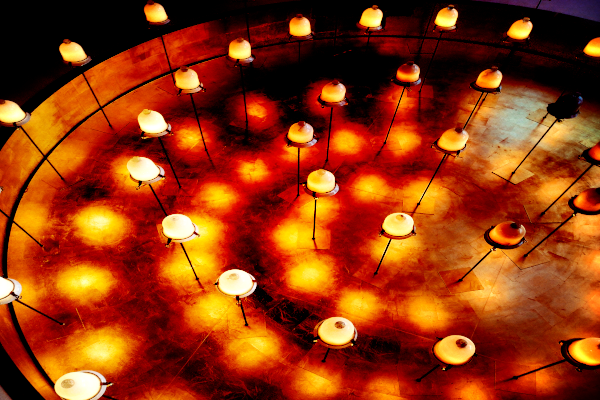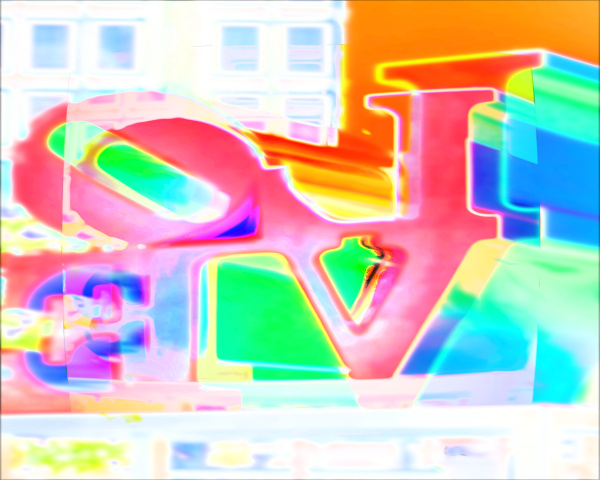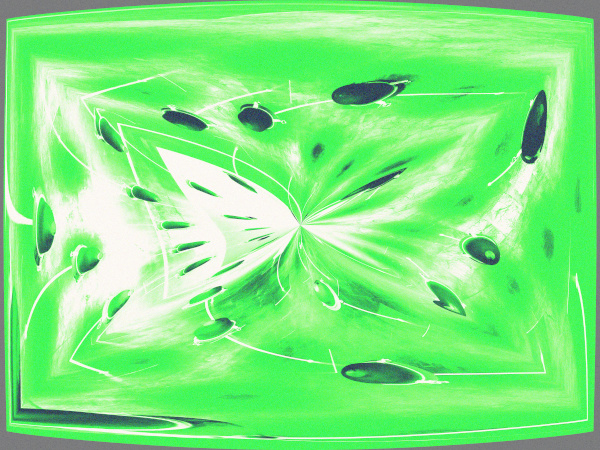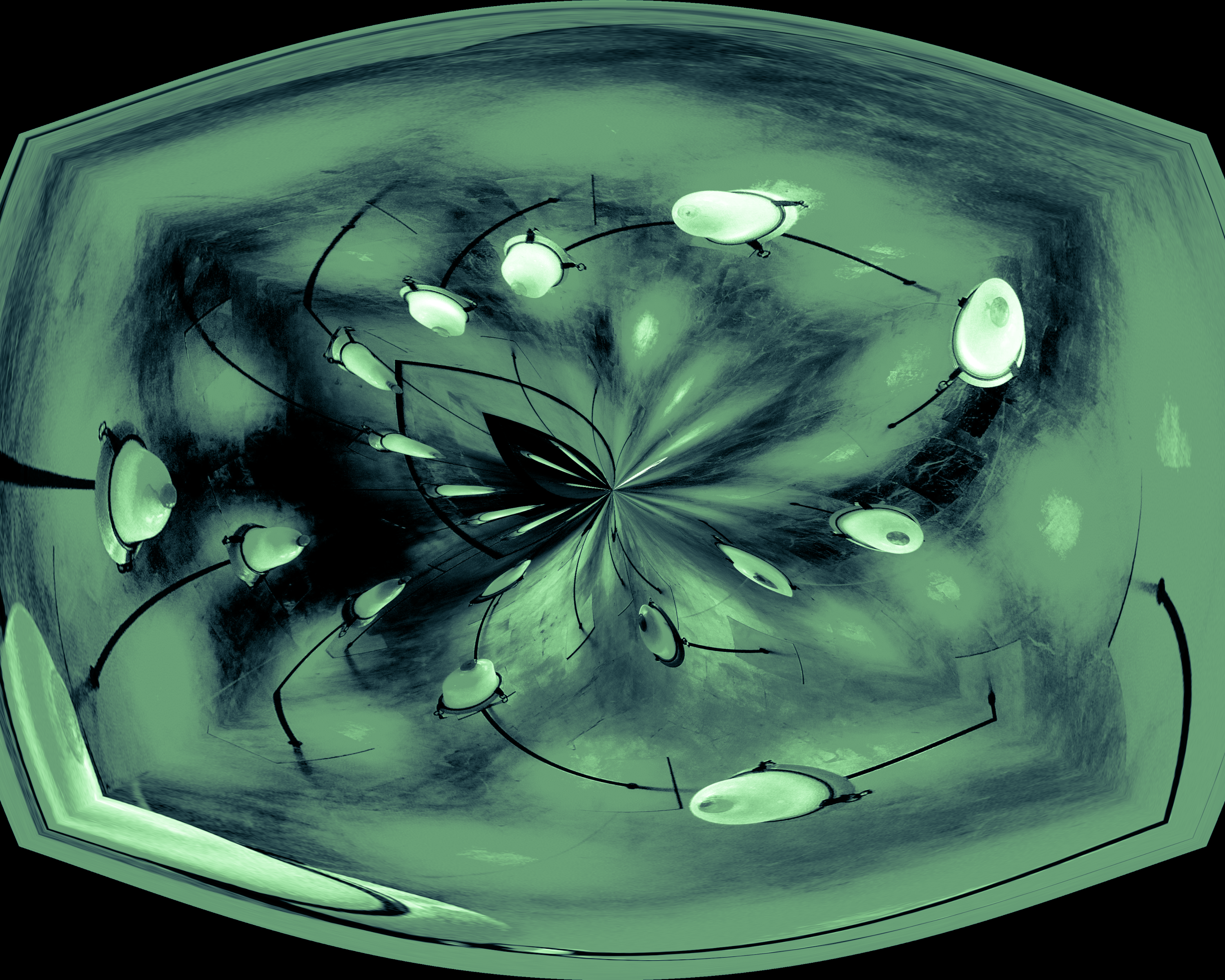
Suraya: More than Piece, Anecdotes of a Gathering with Friends
“Suraya” is a
computer music piece to be performed over loudspeakers,
otherwise known as music for tape or media, lacking live
instrumental or live performance. It might work on
binaural listening situations (headphones) on the Web or
somewhere else. Composition material results from
consolidating several sound synthesis and signal
processing techniques such
as Asymmetric Frequency
Modulation,
Scanned Synthesis and
Synthesis of the Voice by means of
Linear Predictive Code (LPC).
In a more colloquial description, this is a piece
for “Vox” and
audio synthesis spanned over a loudspeaker ensemble
surrounding an audience sidelong and possibly bounded by
ceiling and floor.
Motivation and conceptual features for this composition go back decades and are framed in a story on well lived moments of a music world left behind not only because of cultural and sociological revolutions, but because evolution of procedures that ascertain a value from conceptions to perceptions of expressions manifested on various artforms. It is a tale exploring technicology on how we did it and how we do it, in addition to heuristics opening up for dealing with expressions while continually disentangling arrangements for sketches on new works. Seems “kind of blue” because “Suraya” is not a so spontaneous work. Ideas are product of fabrications on a train of events that lead to capturing a language where cut-of-the-edge music technology was at its culprit. Above descriptions, and thus features of a craft popping out from within a process can be better conjectured on the following lines.
Way back when Enzo Gualteari and I met, center of interest that brought us together was a rod pointing towards music in all directions. Enzo is a Venezuelan brass player and recording artist. By that time, thus far, he was being called for performing gigs all around, considering he had Latin Jazz skills with advantage on improvisational dexterousness appealing to contemporary performance. Our comradeship wheels about a vision for performance of good music no matter style or even genre, though he stays off micro-tuning and twelve tone stuff. His style is more into Instrumental music instead of Electroacoustic, but we correlate on liking whatever comes out on music gear magazines and what they showcased on windows of music stores in New York. Few years went by until days ago, asteroids lined out, and we were able to meet in person for reminiscing and catching up. Among stories we grasped on one pertaining a visit to a studio at South Street in Philadelphia. Those were the golden days of vinyl LP's, or in today's jargon, “analog days”, on which selling, buying and collecting records was a practice among all of us.
Enzo convinced me on going to a studio at South Street considering at the time I had never seen professional equipment and how they made multi track recordings that indeed clinched the music world as a prolific business. Ever since overdubbing was created, performers would ease up, cause they didn't have to deal with issues within real time performance for good or bad. Also because recordings assured the best vocal or instrumental take. Consequently, those were the days of coaching and producers and a different kind of creativity revolving on the equipment at hand. The day we went in, Enzo was part of a Latin Jazz session and recording was taken place. Quickly I realized people were as busy as they could be because they were fixing up the rhythm sections of a song that I now recognize as “Blue Bossa”, by using tape editing and overdubbing. Sound engineers were kind enough to allow us to go inside the control room of this studio.
On the South Street studio, the amount of analog equipment was overwhelming. Amidst all gear, recorders, a mixing console, microphones and speakers for dealing with sound signals, would stand out. All recorded sounds ended up on two-inch tape reels for later mixing on two-track quarter-inch recorders. -Just looking at a two-inch reel and seeing it turning will astonish anyone-. Breaking forth, were black boxes bolted to a handful of racks hosting audio effects known as echoing, doubling, flanging. Obviously harmonizing units that will make a dreadful track really come alive were also online. Most of the equipment carried out metering gauges displaying amounts of signal, in addition to switches and knobs for calibrating them. But for most of time, eyes were captivated by a huge state of the art forty-eight-channel mixing console on the middle of the control room. -Its patch bay was a mind blower-. All around surrounding this control room, there were loudspeaker monitors symmetrically positioned so that ears of the engineer (producer perhaps) would be on a sweet spot. A bit hiding on the studio side, there was a Bösendorfer grand piano that luckily enough we were able to try, while musicians were taking a break.
Recalling our episode, if we had planned it, things would not been as nice as they were. That day we ended up leaving South St. Studio at dusk, thinking on going for coffee or a drink in order to recollect our thoughts. We walked to the 'Septa' subway station for riding onto City Hall's station and then walking Chestnut Street to chill down in a quite place. Once seated, there was questioning and few answers on our minds, however on top of all recollecting, there was euphoria on what happened, thereby confronting what 'magic' in music really is. Ten or twelve weeks passed before the pressed LP Album from that recording session was released. I was able to get it at a basement record store, under the stairs to the gate at Market street on Philly's Reading Terminal. Those were the days albums had art, photos, essays and descriptions or stories to make sense about what we were listening. Among descriptive texts, there were technological descriptions and details on how recording of tracks were made. This way we were able to find out not only about “Ampex Recorders” but also about “Eventide Harmonizers” and “Lexicon Reverb”. Getting acquainted with these devices was critical for our musicianship cause we deciphered how some textures sounded so good. From there on we knew that music should be as natural as possible, but a “twist of lemon” would not hurt to make it sound as good as reasonable it can be perceived.
After years of absence from seeing each other, acquaintance fetches remembrance exhorting all enigma circumventing music technology, and the zest we get from it. Questions without answers prevail but now in a more mature state of mind. Assertions such as, was music before technology, or would there be inspiration as consequence of technology?, now bother somehow. Further on, should we stick to live performance or give up for studio recording?. To say the least, everything still seems so paradoxical!. On these thoughts, we casually decided to inquire and go to the studio that brought us together years ago, even though our paths now seem not so orthogonal but fairly parallel. Studio had changed ownership and now was located on the “Fishtown” neighborhood of Philadelphia. Not so surprising rooms are different, and equipment is not a collection of black boxes but a another thing (not a console anymore). Though carrying legacy, their Bösendorfer still has its place.
On the new studio not much of analog equipment was at sight. Seems that control room notion has been surpassed by sound engineers working in cubicles that house digital workstations, in addition to little near field monitor speakers and tiny consoles. Sadly a smartphone picture would not be able to capture what is going on, while they are manipulating or processing on these workstations, considering operators monitor audio on state of the art headphones, and a fraction what they are doing is modestly visualized on their screen. But don't take our word with a twist of melancholy, everything on this studio would capture sight even on airline pilots used to cockpits. It appears that studio business favors multimedia content editing, on route to entertainment products with a bit of creation nowadays. Song recording doesn't seem so feasible, but in spite of it, recording affairs likewise carry on memorizing and archiving whatever is in sound material. Continuing on our journey of this facility, we were surprised when we entered a room with an archive of analog “full” and “two-track” quarter inch analog tapes. Teasing our curiosity, we wanted to find out what sort of content tapes have but were told, only way to find out was to rent a “Studer” analog “quarter-inch” recorder, and digitize their content. Conversing the issue, owners expressed they were waiting for a grant to fund digitizing and archival of whatever was in these tapes.
Altogether, we found that many of these tapes were inherited, or on loan, from nearby Temple University. Apparently, these are recordings of historical music performances, talks, research on linguistics and audios, among others. What caught our attention was a a set of tapes donated to Temple's WRTI by Bell Labs, and marked with numbered tracks, product of experimentation on voice synthesis and manipulation of spoken words. Since renting a recorder was out of question, mainly because of time and displacement of equipment, with a phone call we were able to find another sound engineer at WRTI willing to assist us, in order to satiate our concerns. With a contract loan from the studio, we took an handful of tapes to the station where we were able to listen their material. Loaded onto the two-track tape recorder, we were doubtful to what we were really perceiving. To the ears of Enzo gualteri and staff surrounding us, these sounded more like noise or yelling of horrendous beasts and monsters. From a composer's inquire, these sounds were intrinsic worthful and deserving material for an avant-garde composition. Though, we could have digitized sounds from these tapes and put them in a memory stick, we stayed away from doing so because of copyright issues. To my surprise Enzo and everyone over at the station trusted my judgment and presumptions. These recordings might be worth a treasure for those who know what is this kind of content.
On the evening that day, between the studio and the radio station, and after a dynamic morning full of marvel, exhilaration, and astonishment because of findings at North Philly's surroundings, went southwards onto Fishtown neighborhood. There we stopped at Suraya's for coffee, recounting, and loosening up from all emotions. Here our friend Isabel Posner joined us and got involved on all topics of our conversation. Isabel is a visual and media artist from the Pennsylvania School of Arts (PAA). We met her a while ago, precisely on the days of analog, so among other things, we are characterized with same aesthetic directions, not to mention maturity. Aside from teaching, her views gravitate along visuals and technology, although sound sprouts on her language and expressions. More than a witness to our gathering and catching up, a forethought on articulating schema for processes depending on the passing of time was also her reason for being altogether. While not a person bearing comforting zones, her quest has avoided validation of works that belong to colloquial curators on the gallery establishment of the northern east coast of the U.S. Although her journey went through media-land, she was able to confront coding for interactive works, though her bedrock has stayed on the analog path of a maverick Video artist, expressing on moving sculptures and installations. Our chat turned into a quest for real time performance from a musician's perspective and its mapping into visual cues for interacting within subjects. As we agreed upon there is drama in motion, we started grasping on grammars and semantics that unify all expression means. At this time, Enzo felt unease while listening our exchange cause terminology shifted into labyrinths belonging on the twilight zone. Mea culpa!, after not seeing each other for quite some time we got carried away, and this language might be overwhelming for some. In fact, I never thought I had to explain my case of flip flopping ivory keys for “QWERTY” keyboards. Thought it was already understood.
On the studio we barely talked about computers because of the spreadsheet-word-processing association. Now sharing coffee, little I wanted to turn this conversation into signal processing and computer music academic parlance, thus boring and pedantic, and risking we would immediately split. Nevertheless, there was an explanation for following a weird and winding road along research and music technology. A 'bulb' lighted, putting our table on the spotlight, and thereby explanations for my comings and goings were revealed in just a sentence: “there is always a novel component, and there is an element of discovery, when conceiving or perceiving a work of art”. Further on, “Machines and gadgets, like musical instruments, cast tools for assisting searching on grammars for expression means”.
Our table gathering joining an artist, a musician, and a composer, was rather a place of inquiries instead of explanations, solutions and conclusions. Given the context, we were able to untangle insight on those Bell Labs' sounds. Indeed, these were voice signals with re-synthesis of spoken words that would certainly make a good source material for a “computer music” composition. How did I know that?. I answered, one of my mentors precisely worked at Bell Labs on this sort of research and experimentation. Likewise, he touched on the semantics of musical apprehension, and how “Vox Humana” frequently assumes expressive roles. From his perspective, I realized they were testing how to make sense from voice sounds coming from a machine, and then how to come up with rules, given we are exchanging or communicating a symbols in a subject of some sort. Vowels are pitched, though attacks bound beginning and perhaps end of a sound. Vowels embed expressions through changes on their spectral intensity. Pitch and duration manipulation of vowels enable phrasing. Combinations of the above carry out symbolic expression. For Isabel Posner my interpretation of this kind of research rebounded on her presumptions on how voiced gestures are time dependent, and thus expectations on cognition on languages contrasting with spoken words. Enzo thought of textures and phrasing. He quickly realized that maneuvering a digitized voice changes timings and dynamics of what it's been said. Same correlates to an instrumental line, as it's being performed. Combinations of instrumental performance and digitized signals, though not that achievable on real time, mean “performer and machine interaction”. After looking at each other we thought, certainly things are much easier for other, and then why do we do this kind of stuff.
Felt that we could have stayed on these topics until dawn considering our coincidences, sensitivity and artistic qualities, but as time was flying we needed to wrap up. Just like that we decided on a fraternal consortium, meaning that for our next gathering topics on “signal manipulation” and “re-synthesis of spoken words” had to be demonstrated in an aesthetic context, with a work, so that notion of “novel expressions” possibly becomes a frame of reference for us and others. Demonstration is not a good word among artists. Triggering expressions better serves this purpose, but still assesses a proof, something not happening overnight. On my mind, aside from sounds listened at WRTI, mental images of those Eventide and Lexicon “black boxes” from old South Street studio came to my head. That being so, arose potentiality about processing voice sounds, the way it was done on legacy recordings for albums on the “days of analog”. Felt it was a high sloped undertaking but researching on the subject, making sing these voices, and getting a piece done, was enough motivation to face a project of this kind. If I were in another place with another people, I would be doubtful of this kind of impulse or flux. Without further questioning, we agreed upon conceiving a new piece named “Suraya”, not only for environment and spirit surrounding us, but seeing that the place where were tasting our coffee and having these arguments had this illustrious name.
Three of us have nor scheduled our next encounter yet, but looks like we are going to gather again on the days of “autumn leaves”. Currently, Enzo has retired from the recording scene among New York and Philadelphia, after thousands of sessions, and being on more than a handful Billboard hits. Though, he's still a guest on Jazz clubs amid Pennsylvania's and New Jersey's scene. Isabel is preparing her next exhibition on the halls of the Comcast building, making use of language driven gestures for a time changing 3-D installation. On the mean time, here I am working on scheduling a live performance of “Suraya” with loudspeaker orchestra, somewhere on Fishtown with an additional visual layer produced by students of PAA.
Winter and spring are gone, and now undertaking of “Suraya” is done. Here is a piece with voice sounds seldom processed using comb filters, “Eventide Harmonizer” and “Lexicon Reverb and delays”. Paraphrasing my friend Isabel after she listened to some of the sketches: “nuances overlap against each other outlining contrasting textures that run into quasi tonal shades. Sounds of spoken words are synthesized on parallel or sequential lines, giving outstanding phrasing but not semantics. Here we are pushed into a colorful tonal spectra”.
If conjectures are not sufficient, as per our gathering's acknowledgment, “works that contour something need to be enigmatic”. Actually, mystery on a composition like “Suraya” lies on spoken words that turn into chanting, in such wise generating machine sounds. Fragments of recorded voice allocutions recorded years ago for another composition, were part of the process. Manipulations were achieved using closed approximations to algorithms, originally develop at Bell Labs, thirty or forty years ago, and courtesy of colleagues that teach on the field. These algorithms encompass sound analysis and sound re-synthesis with dexterousness based on Linear Prediction. The use of Scanned Synthesis and Asymmetric Frequency Modulation encompass shades for texturing on the piece. Scanned Synthesis is a method for obtaining sound using “scanning” of vibrations from flexible or elastic material, such as rubber or springs. Asymmetric FM is a method for getting uneven harmonics for interesting and colorful spectra. Stay tuned for next performance at a listening space near by, or listen to “Suraya” on its binaural, non visual version on the Web.


